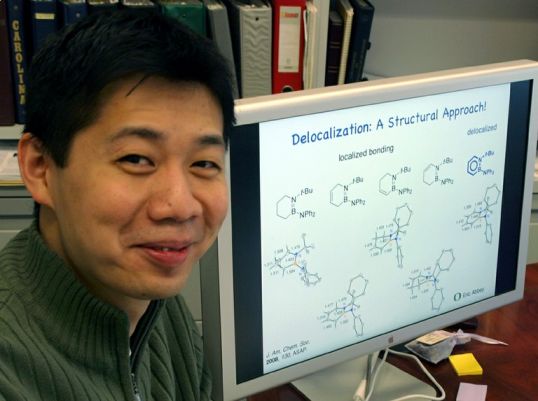A scientific team of chemists and biologists successfully demonstrated that unique boron compounds synthesized by him react with biologically active enzymes, a finding that could lead to the development of new approaches to the preparation of effective drugs

A scientific team of chemists and biologists successfully demonstrated that unique boron compounds synthesized by him react with biologically active enzymes, a finding that could lead to the development of new preparation approaches for effective drugs.
In May of 2008, the chemist Shih-Yuan Liu from the University of Oregon reported in the scientific journal Journal of the American Chemical Society that his laboratory was able to prepare boron-nitrogen compounds with electronic and structural similarity to the extremely important basic compound benzene in chemistry. These novel compounds are another tool for possible uses in biomedical research and in the field of materials science.
The research team prepared a benzene substitute known by its scientific name as "1,2-dihydro-1,2-azaborines" (the entry from Wikipedia) with an electronic Al-localization suitable for aromaticity - a central concept in chemistry in which certain ring structures have unusual stability.
Now, in a new article in the scientific journal Angewandte Chemie, the same scientists demonstrate how their novel compounds do fit into non-polar hydrophobic niches of a well-known and well-known enzyme of the lysozyme type that was discovered back in 1921 and is widely used in biomedical research.
The findings were obtained following the reaction of the compounds with the enzyme, the formation of the resulting conjugate and its examination by X-ray crystallography.
"I feel that this is a big and serious step forward," notes the researcher. "Our compounds bind effectively to this particular enzyme and behave similarly to other hydrophobic arene compounds (such as benzene and naphthalene) that resemble systems that exist in nature. Our compounds contain polar components, so it was doubtful whether they would actually bind to the hydrophobic niches of the enzyme, but they did, similar to corresponding carbon compounds."
In principle, the team of researchers was able to use boron compounds, essential nutrients common in plants - but which nature skipped during evolution for other creatures - as alternatives to carbon compounds in the preparation of medicinal materials. The use of boron compounds in the field of biomedicine is not new, but it is greatly delayed due to their instability. Along with time, during the last decade they have gained a lot of interest in the scientific community. Bor compounds are tested by several pharmaceutical companies and some of them are used today as anti-bacterial drugs and in the fight against blood cancer.
The progress for which these researchers are responsible reinforces the idea that boron-based compounds could be used as new drugs or as monitoring agents in the body's tissues. "This study provides the first ever experimental evidence that enzymes in our bodies do not distinguish between our artificial compounds and their carbon-based counterparts," explained the lead researcher.
